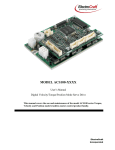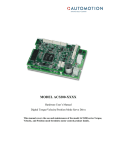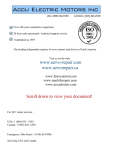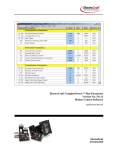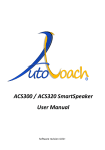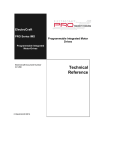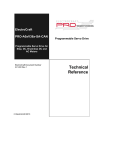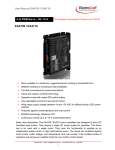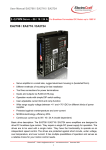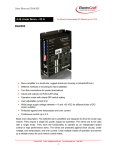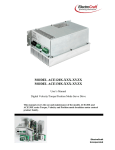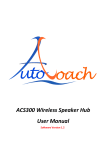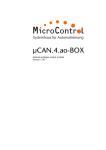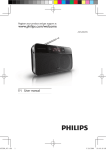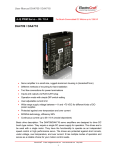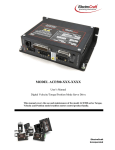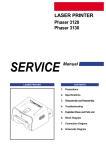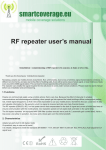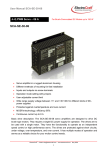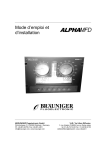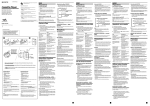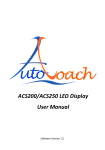Download User Manual - ElectroCraft
Transcript
MODEL ACS300-XXXX User’s Manual Digital Velocity/Torque/Position Mode Servo Drive This manual covers the use and maintenance of the model ACS300 series Torque, Velocity and Position mode brushless motor control product family. ElectroCraft Incorporated ACS300 User Manual Title: ACS300 User Manual Installation and Operation Type of Documentation: User Hardware Manual Document Type code: ACS300UM Rev 1.0 09‐22‐09.doc Internal File Reference: Purpose of Documentation: Document Number: A11014 This documentation describes… • Installation and operation of the ACS300 family drive. Record of Revisions: RELEASE NUMBER DATE DESCRIPTION COMMENTS 1.0 09/22/09 ElectroCraft changes Initial Release Copyright: ©2009 ElectroCraft MI, Inc USA. All rights Reserved. Copying this document, giving it to others and the use or communication of the contents there of without express authority, is forbidden. Offenders are liable for the payment of damages. We reserve the right to modify our products at any time. Information, specifications, and material data that appear within this user manual are subject to change without notice. For the latest revision of this manual, please check our web site or contact ElectroCraft. Validity: The specified data is for product description purposes only and may not be deemed to be guaranteed unless expressly confirmed in the contract. All rights are reserved with respect to the content of this documentation and the availability of the product Published by: ElectroCraft MI, Incorporated P.O. Box 7746, Ann Arbor, Michigan 48108 USA Tel.: 734‐662‐7771 • Fax: 734‐662‐3707 http://www.electrocraft.com ElectroCraft, Inc. 2 ACS300 User Manual Table of Contents 1 ACS300 Controller ……………………………………………………………………………………………………….… 5 1.1 Overview ………….……………................................................................................... 5 Software .………….…………………………………………………………………………………………….. 5 Parameters & Variables ……………………………………………………………………………….…. 5 ACS300 Introduction ..…..………………………….………………………………………………………..…….… 6 2.1 Amplifier ……………………………………………………………………………………………………….. 6 2.2 Theory of Operation …………………………………………..………………………………………….. 6 Product Safety Precautions ………………………………………………………………………………….……… 7 3.1 Operation …………………………………………………………………………………………………….…. 7 3.1.1 Use of ACS300 Jumpers …………………………………………………………………….. 8 3.2 Storage and Transportation ……………………………………………………………………….…… 9 3.3 Installation …………………………………………………………………………………………….……….. 9 3.4 Wiring …………………………………………………………………………………………………………….. 10 3.5 Life Support Policy ………………………………………………………………………………………….. 10 Checking Product on Delivery ……………………………………..………………………………………………. 11 Recommended Cabling and Installation ……………………………………………………………………….. 12 ACS300 Installation and Setup ……………………………………………………………………………………… 13 6.1 Mounting the ACS300 …………………………………………………………………………………….. 14 6.2 Environmental Conditions ………………………………………………………………………………. 14 6.3 Installation in the Control Panel ……………………………………………………………………… 14 6.4 Use of the ACS300 Jumpers …………………………………………………………………………….. 14 6.5 Simplified ACS300 Block Diagram ……………………………………………………………….….. 15 6.6 ACS300 Connector Description ……………………..………………………………………………... 16 6.6.1 J1: Digital I/O ……………….……………………………………………………………………. 17 6.6.2 J2: Analog I/O …………………………………………………………………………………….. 17 6.6.3 J3: RS‐232 …………………………………………………………………………………………. 18 6.6.4 J4: Encoder Feedback ………………………………………………………………………… 18 6.6.5 J5: Hall Feedback ……………………………………………………………………………... 18 6.6.6 J6 / J7: Dual CAN ……………………………………………………………………………….. 19 6.6.7 P1: DC Input ………………………………………………………………………………………. 19 6.6.8 P2: DC Input / Motor Phase …………………………………………………………….... 19 6.6.9 P4: Motor Temperature …………………………………………………………………….. 19 ACS300 Status LED’s ……………………………………………………………………………………………………… 20 7.1 User Ready ……………………………………………………………………………….………………….….. 20 7.2 User Power ……………………………………………………………………………………………………… 21 2 3 4 5 6 7 8 9 10 11 12 Introduction to ElectroCraft CompletePower™ Plus …………………………………………………… 22 Recommended Minimum Hookup ……………………………………………………………………………….. 23 9.1 Diagram ………………………………………………………………………………………………………….. 23 9.2 Wiring Diagrams for Optional User Interfaces ………………………………………………… 24 First Time Operation …………………………………………………………………………………………………….. 25 10.1 Phasing the Motor …………………………………………………………………………………………… 25 10.2 Using ElectroCraft CompletePower™ Plus ………………………………………………………. 25 10.3 ACS300 Electrical Ratings ……………………………………………………………………………….. 26 ACS300 Dimensional Drawing ……………………………………………………………………………………… 28 List of Mating Connectors …………………………………………………………………………………………….. 29 ElectroCraft, Inc. 3 ACS300 User Manual 13 ACS300 Interface Circuitry ……………………………………………………………………………………………. 30 13.1 J1: Digital I/O …………………………………………………………………………………………………… 30 13.2 J2: Analog I/O ………………………………………………………………………………………………….. 31 13.3 J3: RS‐232 Interface …………………………………………………………………………………………. 32 13.4 J4: Encoder Interface Overview ……………………………………………………………………… 33 13.4.1 J4: Encoder Interface ………………………………………………………………………… 33 13.5 J5: Hall Interface Overview …………………………………………………………………………….. 33 13.5.1 J5: Hall Interface ………………………………………………………………………………. 33 13.6 J6 and J7: CAN Interface …………………………………………………………………………………. 34 13.7 Motor Temperature Overview ………………………………………………………………………… 35 13.7.1 Motor Temperature ………………………………………………………………………….. 35 External Shunt ……………………………………………………………………………………………………………….. 36 14.1 Use & Selection ………………………………………………………………………………………………… 36 14.2 Connecting shunt board ………………………………………………………………………………….. 37 Model Identification ……………………………………………………………………………………………………... 38 Appendix A ……………………………………………………………………………………………………………………. 39 14 15 16 The remainder of this page is intentionally left blank. ElectroCraft, Inc. 4 ACS300 User Manual 1 1.1 ACS300 Controller Overview Software This manual describes the installation and operation of the ACS300 series of digital high voltage servo‐amplifiers manufactured by ElectroCraft MI, Inc. This document applies to serial numbers ending with xxxx0105 and beyond. The ACS300 amplifier is: • Configurable operation modes: Torque, Velocity, and Position. • Selectable BLAC (sine wave, flux vector) or BLDC (Six step, trapezoidal) commutation. • 4 Quadrant performance. • Phase output, PWM controlled output. • Full digital control of all loops • Variable servo rate from up to 16 kHz. • Loop tuning via serial interface (No potentiometers!). • Drive setup & status information available serially via RS232 link. • 12 – 48 VDC input power supply range. • Output current of 15 Amp continuous, 30 Amp peak. • Compact package size. • ElectroCraft CompletePower™ Plus graphical windows interface for Setup, Configuration and Tuning. For further documentation support of software and its usage, refer to the ElectroCraft CompletePower™ Plus software user’s manual. Parameters and Variables For further documentation support of parameters, variables, commands and graphing refer to the ElectroCraft Parameter Guide. ElectroCraft, Inc. 5 ACS300 User Manual 2 ACS300 Introduction 2.1 Amplifier The ACS300 is a fully digital servo amplifier that uses DSP technology to provide a powerful feature set that is fully configurable by means of a RS232 serial port. The ACS300 servo drive is configurable as a Torque, Velocity, or Position mode servo amplifier. The ACS300 is designed to operate a single 3 phase Brushed or Brushless DC or AC, permanent magnet motor. The motor may have either a WYE or Delta wound stator. The ACS300 provides commutation using Hall sensors or encoder feedback. The ACS300 Torque, Velocity or Position modes accept serial +/‐ 10 volt DC analog or digital PWM. 2.2 Theory of Operation The ACS300 operates as a “mode configurable” digital servo amplifier. This product is typically applied as a component within an end use industrial application. Within industry, application requirements for servo amplifiers vary widely. For example, one application may require an amplifier with an analog input reference for speed. Another application may require an amplifier that offers torque control and Hall sensor commutation only. For this reason the ACS300 offers a choice of many different servo‐ operating modes. This flexibility is made possible because all of the control functions within the ACS300 are implemented in software. The ACS300 physical I/O and closed loop functionality are selected using the ElectroCraft CompletePower™ Plus software setup utility. See Section 7, Introduction to the ElectroCraft CompletePower™ Plus software, and the ElectroCraft CompletePower™ Plus software User Manual for additional information on using this software. The internal firmware architecture of the ACS300 is modular. ACS300 software is built as a series of components (or modules) that are linked together to form an ACS300 servo‐operating mode. ACS300 software components are stored in flash memory. These components exist as Reference input modules, Feedback modules, PI (D) control modules, commutation modules and firmware extension modules. An internal digital signal processor is used to read I/O signals, motor feedback signals and to process serial communication messages. Flash memory inside the ACS300 is used to store a library of modular software components. RAM memory is used for data logging and graphical tuning of the ACS300. The serial EEPROM provides nonvolatile memory for retention of user‐configured parameters and operating mode. ElectroCraft, Inc. 6 ACS300 User Manual 3 Product Safety Precautions READ THIS ENTIRE SECTION BEFORE ATTEMPTING TO USE THE ACS300 SERVO DRIVE! GIVE SPECIAL ATTENTION TO ALL BOLD PRINT ITEMS. WARNING! To operate your control successfully, these minimum safety precautions MUST be followed to insure proper performance without injury to the operator and damage to motor or control. FAILURE TO OBSERVE THESE SAFETY PRECAUTIONS COULD RESULT IN SERIOUS BODILY INJURY, INCLUDING DEATH IN EXTREME CASES. 3.1 Operation 1. 2. Do not touch any of the output connector pins from connectors P1 (DC Input) or P2 (Motor Output) when power has been applied. The voltages at these connector pins are dangerous and can produce an electric shock. Bare wires from adjacent connector pins must never be allowed to touch one another. P2 pin 6 must be connected to an external earth ground. Follow wiring procedures carefully. Know and understand which connectors are NOT electrically isolated from the DC voltages within the drive. 3. Read ElectroCraft’s Life Support Policy in section 3.5 for application limitations. 4. Follow precautionary guidelines in this manual with regard to proper installation of an external shunt resistor. See Section 13 of this manual. 5. Do not operate the control in an explosive area or near explosive or flammable materials. Do not use the control in environments where it is likely to be exposed to strong and/or frequent static discharge. Conduct trial operations on the servo drive alone with the motor shaft disconnected from the machine to avoid any unexpected accidents. Motor shaft should be uncoupled and free to rotate without coming in contact with user or any stationary object during set up and preliminary operation. 6. 7. 8. Under no circumstances should a phase output from the control be connected to anything other than a passive inductive/resistive motor load. Short circuit protection for the drive is limited to momentary conditions only! Repetitive short circuits on any of the output pins for P1 and 2 will likely cause permanent damage to the ACS300. 9. Never touch any moving parts while the motor is running. Failure to observe this warning may result in injury. 10. Excessive speed and current can destroy some motors and possibly injure the user. Check the motor manufacturer's specifications to ensure that the maximum current and voltage for your control model, does not exceed their limitations. ElectroCraft, Inc. 7 ACS300 User Manual 11. External methods are advisable to limit both the top speed and travel motion of the motor and its load. Whenever the ACS300 drive is disabled for any reason, the motor is placed into a free/spinning coast mode. 12. When using the servomotor for a vertical axis, install safety devices to prevent work pieces from moving due to occurrences of over travel. Failure to do this may cause injury to work pieces or person. 13. Provide an appropriate stopping device on the machine side to ensure safety. A holding brake for a servomotor with brake is not a stopping device for ensuring safely. Failure to observe this warning may result in injury. 14. Do not parallel multiple motors off the same control. 15. Do not make any extreme adjustments or settings changes of parameters. Failure to observe this caution may result in injury due to instable operation. 16. Do not turn the control on or off frequently unless necessary. Failure to observe this caution may cause internal parts to deteriorate. 17. Avoid plugging connector P1 or P2 into the control while live power is applied to the connecting cables. Ignoring this precaution will cause electrical arcing at the connector pins, which can cause permanent connector damage. ElectroCraft recommends using a disconnect switch ahead of P1 and P2 if the ACS300 must be disconnected often. 18. Do not remove the connectors on ports P1, P2, J1 through J6 from the control while the motor is operating. 19. Do not service or modify this product. Only authorized personnel must perform disassembly or repair of the drive. Failure to observe warning may result in injury or damage to product. 20. Always operate the ACS300 within the prescribed voltage limits. Any attempt to operate outside these bounds may result in damage to the ACS300 control. 3.1.1 Use of ACS300 Jumpers ACS300 Jumpers JU201 and JU202 – DC Operating Voltage 1. The ACS300 has two jumpers that must be set according to the desired input DC operating voltage range. Failure to set these jumpers correctly can result in permanent damage to the ACS300. Please see section 6.4 “Use of ACS300 Jumpers JU201 and JU202” and select the proper jumper setting for your application before applying power to the ACS300. ACS300 Jumpers JU1, JU2, JU3, JU4 – Use of Encoder Feedback 1. The ACS300 has jumpers that must be set according to the type of feedback device used. With a differential encoder feedback only A, A!, B, and B is used. User may leave Z and Z! unconnected. If using a single ended encoder feedback A and B, (and not the A! and B!) is used, all four jumpers on the daughter card, right next to the encoder connector J4, must be shorted. These are JU1, JU2, JU3 and JU4. You can then leave Z and Z! unconnected. 2. If only Hall Effect is used and no encoder at all, leave the encoder connector unconnected. 3. See section 6.6.4, J4 Encoder Interface Circuitry, for additional information. ElectroCraft, Inc. 8 ACS300 User Manual 3.2 Storage and Transportation 1. 2. 3. Do not store or install the product in the following place a. Locations subject to temperature outside of the range specified. b. Locations subject to humidity outside the range specified. c. Locations subject to condensation as the result of extreme changes in temperature. d. Locations subject to corrosive or flammable gases and liquids. e. Locations subject to dust, salts, or iron contaminants. f. Locations subject to exposure to water, oil, or chemicals. g. Locations subject to shock or vibration. Failure to observe this caution may result in fire, electric shock, damage to the product. Do not hold the product by the cables or motor shaft while transporting it. Failure to observe this caution may result in injury or malfunction. Store the ACS300 drive when not in use, in temperatures between ‐20 to +85 degrees C. 3.3 Installation 1. 2. 3. 4. 5. 6. Take appropriate and sufficient countermeasures when installing systems in the following locations. a. Locations subject to static electricity or other forms of noise. b. Locations subject to strong electromagnetic fields and magnetic fields. c. Locations subject to possible exposure to radioactivity. d. Locations close to power supplies including power lines. e. Failure to observe this caution may result in damage to the product. Keep any external shunt resistor away from flammable materials. Read Section 13 carefully for more shunt installation details. Never use this product in an environment subject to liquids, corrosive chemicals or gases, or combustibles, or where foreign materials are allowed to fall onto or collect inside the drive Failure to observe this caution may result in electric shock or fire. Do not place heavy objects on the product. Failure to observe this warning may result in stopping operation of the product. Do not cover or prevent air from escaping or entering through the vents with obstruction or foreign object. Failure to observe this caution may cause internal elements to deteriorate resulting in malfunction or fire. Provide the specified clearance between the drive and the control panel or with other devices. Provide sufficient space around the drive for cooling by natural convection or provide cooling fans to prevent excessive heat, see section 6.3 for details. Failure to observe this caution may result in fire or malfunction. ElectroCraft, Inc. 9 ACS300 User Manual 3.4 Wiring 1. 2. 3. 4. 5. 6. 7. 8. 9. Verify ALL wiring BEFORE applying power to the control and motor. Motor may spin or oscillate uncontrollably if improperly wired. Drive may be damaged or improper wiring may prevent drive from operation. The ground P2, pin 6, MUST always be connected to an appropriate external earth ground. Connect the ground terminal to the electrical codes (ground resistance should be less than 100 ohms. Improper grounding may result in electric shock or fire. Do not connect a three‐phases or any supply power to the U, V, and W terminals. Failure to observe this caution may result in injury or fire. Securely connect the power supply terminals and motor output terminals. Failure to observe this caution may result in fire. Do not bundle or run power and signal lines together in the same duct. Keep power and signal lines separated by at least 30cm. Use twisted‐pair shielded wires or multi‐core twisted pair shielded wires for signal and encoder feedback lines. Always use the specified power supply voltage. An incorrect voltage may result in burning. Be particularly careful where the power supply is unstable. An incorrect power supply may result in damage to the product. Install external breakers or other safety devices against short‐circuiting in external wiring. Failure to observe this caution may result in fire or damage to the control. 3.5 Life Support Policy READ THIS ENTIRE SECTION BEFORE ATTEMPTING TO USE THE ACE SERVO DRIVE! GIVE SPECIAL ATTENTION TO ALL BOLD PRINT ITEMS. ElectroCraft’s products are not authorized for use as critical components in life support devices or systems without the express written approval from ElectroCraft MI, Incorporated. 1. Life support devices or systems, are devices or systems which are intended for surgical implant into the body, or support or sustain life, and whose failure to perform, when properly used in accordance with instructions for use provided in the User's Manual and in the labeling, can be reasonable expected to result in a significant injury to the user. 2. A critical component is any component of a life support device or system whose failure to perform can be reasonably expected to cause the failure of the life support device or system, or to affect its safety or effectiveness. ElectroCraft, Inc. 10 ACS300 User Manual 4 Checking Product on Delivery When your package arrives, inspect the shipping box and the unit carefully, and save ALL packing materials. Compare the packing slip against all items included in the shipping box. Any shortages or other inspection problems should be reported to ElectroCraft immediately. The following procedure is used to check products upon delivery. Check the following items when your ACS300 is delivered. • Verify that the model number marked on the nameplate of the drive(s) is the correct model ordered. • Check the overall appearance. Check for damage or scratches that may have occurred during shipping. If any damage, or if the unit is the wrong type, contact your ElectroCraft sales representative immediately. Your ACS300 has arrived carefully packaged from ElectroCraft MI, in an antistatic bag. As you unseal this bag, inspect the contents carefully. There should not be any loose or damaged parts inside. Never attempt to operate or power‐up the drive if there is any visible external damage or if it sounds as though there are loose materials inside the chassis. While unpacking, if you discover any loose or damaged parts, notify ElectroCraft within two working days. ElectroCraft recommends that all packing materials be saved in the event that the ACS300 needs to be shipped back. Always place the ACS300 in the same antistatic bag used in the original shipment. Abundant anti‐static filler material should always be placed around the ACS300 so that it cannot shift inside the box. Extreme care should be exercised when placing packing material around all external connectors to prevent mechanical stress damage. All material to be returned to ElectroCraft must have a Return Material Authorization (RMA) tracking number assigned before shipment. This may be obtained by contacting the ElectroCraft Service Dept. Any product returned without this number will be rejected by ElectroCraft. Always insure your shipment for the proper replacement value of its contents. ElectroCraft will not assume responsibility for any returned goods that have been damaged outside of our factory because of improper packaging or handling. All goods shipped to ElectroCraft must be shipped FREIGHT PREPAID. ElectroCraft, Inc. 11 ACS300 User Manual Recommended Cabling and Installation 5 +5VDC SHIELD SHIELD TERMINATE SHIELD TO COMMON GROUND SEPARATELY FROM ANALOG GROUND . TERMINATE SHIELD AT THIS END ONLY. USER INTERFACE USER INTERFACE OPTIONAL QUICK START PCB ENABLE / RESET RUN / STOP COMMON GND J6/7 J3 J1 1 2 3 TXD RXD CTS RTS DIGITAL GND CAN HI CAN LO DIGITAL GND +5VDC ENC ENCODER A ENCODER !A ENCODER B ENCODER !B ENCODER Z ENCODER !Z DIGITAL GND DIGITAL GND ACS300-xxxx 1 2 3 4 5 1 2 3 4 5 6 7 8 9 10 +5VDC OUT +5VDC OUT ENABLE / RESET RUN / STOP STEP DIRECTION ENABLED READY DIGITAL GND DIGITAL GND +5VDC HALL HALL 1 HALL 2 HALL 3 DIGITAL GND DIGITAL GND 1 2 3 4 5 6 7 8 9 1 2 3 4 5 6 J4 J5 FRAME SHIELD SHIELD MOTOR TERMINATE SHIELD TO COMMON GROUND AS SHOWN. DO NOT CONNECT SHIELD TO FRAME. DO NOT CONNECT SHIELD AT MOTOR END. ENCODER / HALLS SHIELD SHIELD J2 AN1+ AN1ANALOG GND AN2+ AN2ANALOG GND ANALOG GND PIN DESCRIPTION 1 TEMP + 2 TEMP - - U V W F 6 PIN DESCRIPTION + BUS - BUS PHASE U PHASE V PHASE W FRAME 1 2 3 4 5 6 1 + P2: MOTOR PHASE 1 P4: TEMP INPUT 2 AN1+ AN1ANALOG GND 1 2 3 4 5 6 7 PIN DESCRIPTION 1 VDC LOGIC+ 2 VDC LOGIC - 1 P1: POWER INPUT 2 KEEP FRAME GROUND WIRES AS SHORT AS POSSIBLE MOTOR CABLE SHIELD 12 ElectroCraft, Inc. P/N 1001436 POWER CABLE SHIELD TERMINATE SHIELDS FOR MOTOR AND POWER CABLE TO FRAME GROUND. TERMINATE SHIELD AT THIS END ONLY. USER SUPPLY TERMINATE SHIELD TO ANALOG GROUND SEPARATELY FROM COMMON GROUND. TERMINATE SHIELD AT THIS END ONLY. ACS300 User Manual 6 ACS300 Installation and Setup READ ENTIRE USER MANUAL FIRST BEFORE ATTEMPTING TO USE THIS PRODUCT. If you require further assistance then provided within this manual, please email, call, or fax: ElectroCraft MI, Incorporated® P.O. Box 7746 Ann Arbor, MI USA 48107 (734) 662-7771 Fax #(734) 662-3707 www.electrocraft.com This chapter presents installation procedures and instructions on how to setup your ACS300 drive. The remainder of this page is intentionally left blank. ElectroCraft, Inc. 13 ACS300 User Manual 6.1 Mounting the ACS300 Use this preferred hardware type, see table below, for mounting your ACS300 drive. Mount your ACS300 in the following manner. Base Mounted: Two M3/ No. 6 pan head screws. Include spring (locking) washer with plain washer. Weight: Plate: 0.49lb (222g) or optional heatsink: 1.30lb (590g). Size: 3.38” (85.73mm) x 5.25” (133.35mm) x 1.03” (26.29mm): Plate or 2.22” (56.44mm): Heatsink. 6.2 Environmental Conditions in the Control Panel • • • • 6.3 Storage Temperature: Humidity: Operating Temperature range: Vibration: ‐20‐85 degree C 5‐95%RH, Non‐condensing 0‐50 degree C Install a vibration isolator beneath the drive to avoid subjecting it to vibration. Installation in the Control Panel Base Mount When installing the ACS300, provide at least 10 mm (0.39 in) between units or control panel and at least 50 mm (1.97 in) above and below each drive. Install cooling fans above or below the drive to maintain a constant temperature inside the control panel and to prevent an excess temperature rise around the drive. 6.4 Use of the ACS300 Jumpers JU201 and JU202 Jumpers JU201 and JU202 are located next to the power input connector P1; See Figure 2. JU201: Install JU201 when powering the ACS300 motor and logic inputs with the same supply. Note: When JU201 is installed it is recommended that JU202 is NOT installed. JU202: Install JU202 when the voltage supplied to the logic power input (P1 pin 1) is between +12Vdc and +24Vdc. Remove JU202 when the voltage supplied to the logic power input is greater than +24Vdc. The standard configuration is that JU202 is NOT installed (left open). When installed, JU202 bypasses some circuitry that protects the internal logic power supplies from voltages above +48V. ElectroCraft, Inc. 14 ACS300 User Manual 6.5 Simplified ACS300 Internal Block Diagram This following diagram is provided to familiarize the user with the internal architecture of the ACS300. An internal digital signal processor (DSP) is used to read I/O signals, motor feedback signals and to process serial communication messages. ROM memory inside the ACS300 is used to store a library of modular software components. RAM memory is used for data logging and graphical tuning of the ACS300. The serial EEPROM provides nonvolatile memory for retention of user‐configured parameters and operating mode. EEPROM memory is also used to extend the program functionality of the ACS300. Status LEDs indicate operational state of the ACS300. RS232 serial commuication is used to configure, tune and monitor the ACS300. CAN interface commuication is used configure, tune and tomonitor the ACS300. Drive specific I/O operates independent of user selected servo mode. Drive specific I/O sinals have fixed functionality. Application specific firmware extensions may available from ElectroCraftbethat extend the functionality of this I/O. Serial EEPROM provides non-volital storage of user parameters. ACS300 STATUS LED: YELLOW External RAM is used for data logging/ graphing. POWER LED: GREEN J3RS232 RS232 J6 /J7CAN CAN FROM DC POWER SUPPLY SERIAL EEROM 32K EXT. RAM DSP POR - RESET CIRCUIT J4ENC. J5HALL COMM FLASH ENABLE/RESET ALU STEP/ CMD /PWM J1Digital I/O I/O RUN/STOP INT. RAM READY ENABLED DC-DC POWER SUPPLY HALL / ENCODER INTERFACE DIR 10 BIT ANALOG TO DIGITAL CONVERTERS P1PWR PWM SIGNALS COMMAND AUX THREE PHASE MOSFET BRIDGE Commutation, volocity and position control operate with encoder and / or Hall feedback. Internal DC to DC logic supply provides a wide input voltage operating range: 12 to 48 VDC. MODULATOR FAULT J2Analog IO Internal ROM is configured with a run time library of ACS300 software components. Components are linked together as determined by the user operating mode. P2MOTOR MOTOR TEMP Protected 3 phase MOSFET Bridge. Torque control is achieved using current feedback. Figure 1: ACS300 Block Diagram ElectroCraft, Inc. 15 ACS300 User Manual 6.6 ACS300 Connector Description Drive specific I/O operates independent of the user selected operating mode. Dive specific I/O signals have fixed functionality. These signals are used to interface the ACS300 to an outside control system. They provide signals for enabling, disabling, and monitoring the status of the ACS300. For visual reference to the ACS300 connectors, see Figure 2 below. ACS300-xxxx J1 - DIGITAL I/O J2 - ANALOG I/O J3: RS-232 INTERFACE J1 J4 - MOTOR ENCODER FEEDBACK J2 J3 J7 J6 LED 1 LED 2 J5 J4 J5 - MOTOR HALL FEEDBACK J6/7 - CAN INTERFACE P1 - DRIVE POWER P2 - MOTOR POWER P2 JU201 P1 P4 JU202 P4 - MOTOR TEMPERATURE LED1 - POWER LED2 - READY "STATUS" Figure 2: ACS300 Connector Layout ElectroCraft, Inc. 16 ACS300 User Manual 6.6.1 J1 Connector: User Digital I/O Control, Molex 353621010 Pin # I/O 1 Output 2 Output 3 Input 4 Input 5 Input 6 Input 7 Output 8 Output 9 Output 10 Output Description +5 Volts DC Power. Supplied regulated +5VDC power. 250mA Total available from drive from all pins. +5 Volts DC Power. Supplied regulated +5VDC power. 250mA Total available from drive from all pins. Enable/!Reset Control Signal Input; TTL compatible. +5.5 VDC maximum signal amplitude. 0 Volts minimum. 10K ohm internal pull down. Positive true logic. Forces a master hardware reset for entire drive on a falling edge. Drive recovers beginning after rising edge. Drive remains disabled while logic "0" is applied to this input. Run Command Signal Input; TTL compatible. 5.5 VDC maximum signal amplitude. 0 Volts minimum. 10K ohm internal pull down. Positive true logic. A logic "1" state will allow motor commutation once some level of current is commanded. A logic "0" state places motor into a coast state. Step Input; 0 to +5 VDC logic signal. TTL compatible. 10K ohm internal pull down. Used in step and direction mode. Used with direction input. Direction Input; Zero to +5 Volt logic signal. TTL compatible. +5.5 VDC maximum signal amplitude. 0 Volts minimum. 10K Ohm internal pull down. Selects relative direction of “Step” command. High is “positive” direction. Enabled Output; 0 to +5 VDC logic signal. Logic 0 when drive is in “Reset”. Logic 1 when drive is enabled and initialized. Ready Output; 0 to +5 VDC logic signal. Logic 0 when drive is in “Standby” or “Reset”. Logic 1 when drive is in “Run” mode and ready to deliver current. Common Return. Common Return. 6.6.2 J2 Connector: User Analog I/O Control, Molex 353620710 Pin # I/O Description 1 Input 2 Input 3 Input 4 Input 5 Input 6 7 Input AN1+ Differential Input; ±10 Volt external command signal input. The polarity of this signal controls the relative applied direction of output motor torque. Input is protected to ±24 Volt maximum. AN1‐ Differential Input; ±10 Volt external command signal input. The polarity of this signal controls the relative applied direction of output motor torque. Input is protected to ±24 Volt maximum. Common Return. AN2+ Differential Input; ±10 Volt external signal input. Range and scaling is software configurable. Input is protected to ±24 Volt maximum. AN2‐ Differential Input; ±10 Volt external signal input. Range and scaling is software configurable. Input is protected to ±24 Volt maximum. Common return. Input Common return. ElectroCraft, Inc. 17 ACS300 User Manual 6.6.3 J3 Connector: RS232 Communications, Molex 353620510 Pin # I/O Description 1 2 3 TX RS232 TXD Output, RS232 signal level. RX RS 232 RXD Input, RS232 signal level. CTS 4 5 RTS RS 232 CTS Input, This input not implemented as a ‘Clear to Send” and is only used for programming flash. RS232 RTS Output, This output is not currently implemented. GND Common return. 6.6.4 J4 Connector: Encoder Feedback, Molex 353620910 Pin # I/O Description 1 Output 2 Input 3 Input 4 Input 5 Input 6 Input 7 Input 8 9 ‐ +5 Volts DC Power. Supplied regulated +5VDC power. 250mA Total available from drive from all pins. Encoder "A" Signal; zero to +5 Volt logic signal. Encoder "A!" Signal; zero to +5 Volt logic signal. Encoder "B" Signal; zero to +5 Volt logic signal. Encoder "B!" Signal; zero to +5 Volt logic signal. Encoder "Z" Marker Signal; zero to +5 Volt logic signal. Encoder "Z!" Marker Signal; zero to +5 Volt logic signal. Common return. ‐ Common return. 6.6.5 J5 Connector: Hall Feedback, Molex 353620610 Pin # I/O 1 Output 2 Input 3 Input 4 Input 5 6 ‐ +5 Volts DC Power; Supplied regulated +5VDC power. 250mA Total available from drive from all pins. Hall Signal Input S1; zero to +5 Volt logic signal. 2.2K ohm internal pull up to +5v. Hall Signal Input S2; zero to +5 Volt logic signal. 2.2K ohm internal pull up to +5v. Hall Signal Input S3; zero to +5 Volt logic signal. 2.2K ohm internal pull up to +5v. Common return. ‐ Common return. ElectroCraft, Inc. Description 18 ACS300 User Manual 6.6.6 J6 and J7 Connectors: CAN Communications, Molex 353620310 Pin # I/O Description 1 2 3 In/Out CAN HI; CAN Bus Communication. In/Out CAN LO; CAN Bus Communication. In/Out Common Return. 6.6.7 P1 Connector: DC Logic Power Input, Molex 353620210 Pin # 1 2 I/O Description Input DC Input; +12 to +48 VDC Logic power. Input DC Common Return. 6.6.8 P2 Connector: DC Input / Motor Output, Screw Terminal Pin # I/O Description 1 2 3 Input DC Input; 0 to +48 VDC Motor and Logic (Optional) Power. Input DC Common Return. Output 4 Output 5 Output 6 Input Motor Phase U; peak voltage out of this terminal is dependent upon the incoming voltage on connector P1 pin 2. Peak amperage is model dependent. Motor Phase V; peak voltage out of this terminal is dependent upon the incoming voltage on connector P1 pin 2. Peak amperage is model dependent. Motor Phase W; peak voltage out of this terminal is dependent upon the incoming voltage on connector P1 pin 2. Peak amperage is model dependent. Frame Ground. 6.6.9 P4 Connector: Motor Temperature Input, Molex 353620210 Pin # 1 2 I/O Description Input Temp +; 4.99K ohm internal pull up to +5v. Input Temp –; motor temperature input. PTC, NTC, or switch. Note: Reference section 13.7.1 Motor Temp Circuit Description and Fig. 12 for more information ElectroCraft, Inc. 19 ACS300 User Manual 7. ACS300 Status LED’s In normal operation, the ACS300 is either in a “Ready” state or in an “Error” state. When power is first applied, the green LED will come on steady, meaning that power has been applied. The Yellow LED should be flashing, meaning that the drive is enabled. When the drive is placed into “run mode” the flashing Yellow LED will come on steady. 7.1. User Ready “Status” LED (Yellow) FLASH DESCRIPTION CODE ON Steady OFF POSSIBLE CAUSE RESULT ACS300 is in “RUN” mode. User commanded RUN mode via user interface Processor is inoperable. Drive is in reset Processor fault Improper user supplied +5Volts Drive is being reprogrammed The user commanded standby mode from the user interface A drive error placed the drive in standby mode. ‐ Current is over the designated drive current for more than 0.5mS Internal logic power supplies out of spec (+15V and +5V) Rail voltage > +60V ‐ The user EEPROM has a checksum error or DSP program memory error Clear all faults and STATUS flags Enable three‐ phase PWM ACS300 will stay in a DISABLED mode Drive is in “Standby” mode 1 2 Reserved Over Current Fault 3 4 5 Rail or Power Supply fault Reserved EEPROM Fault or Check sum fault The drive is placed in standby mode 7 To determine cause use the RS232 connection and “CF” command in terminal window, see Note 2 Locked rotor fault Delivered current is greater than user specified current for more than user specified time with no hall transitions. Not applicable Disconnect power from the ACS300 for 1 min. to reset the microprocessor. Then re‐apply power to allow microprocessors to operate Command run mode Toggle the run line, see Note 1 ‐ The drive is placed in standby mode The drive is placed in standby mode ‐ Toggle the run line, see Note 1 ‐ The drive is placed in standby mode (hard fault) ‐ Check the error using the “CF’ command in the terminal page. If the error is “MEMORY EEPROM”, issue the command “CR23130”. If the error is “MEMORY DSP FLASH”, reprogram the DSP. ¾ Warning! Either operation will reset all drive parameters to default state. Reload parameter file after these operations 6 Miscellaneous Faults RECOVERY METHOD The drive is placed in standby mode Toggle the run line, see Note 1 Toggle the run line, see Note 1 Note 1: To toggle the run command, set the Run/! Stop signal to a logic '0' state for 100mS, then back to logic '1' Note 2: If a drive fault does occur and a flash code appears on the Status LED, more details regarding the cause of the fault can be obtained using the “CF” Check Faults command through the drive’s RS232 communications. ElectroCraft, Inc. 20 ACS300 User Manual 7.2. User Power LED (Green) LED Description Possible Cause ON +5 VDC Power Indicator • OFF +5 VDC Power Indicator +5 VDC Power Indicator • DIM • Result On if user power is on No logic power • Logic voltage input to low • • Required to Run Drive will not Run Drive may not run properly Recovery Method • N/A • Apply +12 – 48VDC • Apply +12VDC minimum The remainder of this page is intentionally left blank. ElectroCraft, Inc. 21 ACS300 User Manual 8. Introduction to ElectroCraft CompletePower™ Plus Software ElectroCraft CompletePower™ Plus is a Windows®‐based program used for setup, configuration, system diagnostics and motion control management. ElectroCraft CompletePower™ Plus will lead the user through a step‐by‐step Wizard to create the correct configuration and information required for the user to run a particular motor with a particular drive. The result will be an “Application” containing all of the configuration information required to run the motor with the drive. This section is described within the software user manual: ElectroCraft CompletePower™ Plus software users manual. Please refer to the software user’s manual for full documentation support to properly configure and operate your drive. Windows® is a registered trademark of the Microsoft Corporation. The remainder of this page is intentionally left blank. ElectroCraft, Inc. 22 ACS300 User Manual 9 Recommended Minimum Hookup Apply DC voltage to the Quick Start I/O interface: a. J1 pin 1/2: +5VDC. b. J1 pin 9/10: Common return For additional information pertaining to the optional Quick Start I/O Test Interface, refer to document: Quick Start User Guide.doc(x) located at the ElectroCraft web site. Diagram J4 Figure 3: Optional Drive Setup 23 J1 GND (COMMON) DIGITAL I/O INPUT USER DIGITAL I/O 2 3 4 5 6 7 8 9 10 T REV OU UT IN ED O E N C C BL IN P I IN BL DY D D VD 5VD NA UN TE IR NA EA GN GN 5 + + E R S D E R D D 1 +5 VDC IN ANALOG INPUT 7 6 5 4 3 2 1 J2 STANDBY RESET ENABLE S2 1+ 1- ND 2+ 2- ND ND AN AN AG AN AN AG AG DIRECTION RUN S5 P4 ElectroCraft, Inc. S3 S1 S7 OPTIONAL QUICK START I/O BOARD P/N: 1001436 P2 P1 AN2+ J5 S6 S8 J6 - CAN (P/N: 1002125) OPEN P1 P/N: 1002121 J3 - RS-232 P2 J3 J7 - CAN (P/N: 1002125) OPEN ENABLED READY LED1 P/N: 1002122 J2 - ANALOG I/O 1+ 1- 2+ 2AN AN AN AN J2 LED2 J1 P/N: 1002123 J1 - DIGITAL I/O D LE LE Y AB N EP R AB AD EP EP EN RU ST DI EN RE ST ST S4 ACS300 AN1+ 9.1 USER ANALOG I/O ACS300 User Manual 9.2 Wiring Diagrams for Optional User Interfaces For mating connectors, see section 11. For additional accessories refer to appendix A 1002125 ACS100/200 CAN INTERFACE CABLE DB-9 CONNECTOR RECEPTABLE MOLEX CONNECTOR J6 / J7 1 2 3 4 5 6 7 8 9 1 2 3 CAN LO DIGITAL GND CAN HI N/C N/C N/C N/C CAN HI CAN LO DIGITAL GND ACS200 BOARD N/C N/C 1002121 ACS100/200 RS-232 INTERFACE CABLE DB-9 CONNECTOR MOLEX CONNECTOR J3 1 2 3 4 5 6 7 8 9 1 2 3 4 5 TXD RXD GND CTS RTS I/O BOARD P1 1 2 3 4 5 6 7 8 9 10 N/C N/C N/C ACS200 BOARD N/C 1002123 DIGITAL I/O WIRE HARNESS ACS200 BRD J1 1 2 3 4 5 6 7 8 9 10 RED RED WHITE WHITE WHITE WHITE WHITE WHITE BLACK BLACK 1002122 ANALOG WIRE HARNESS I/O BOARD P2 1 2 3 4 5 6 7 TXD RXD CTS RTS GND ACS200 BRD J2 1 2 3 4 5 6 7 WHITE WHITE BLACK WHITE WHITE BLACK BLACK 1002165 POWER INPUT ASSEMBLY WHITE RED BLACK BLACK I/O BOARD P1 1 2 3 4 Figure 4: Optional Drive Setup Wiring Diagram ElectroCraft, Inc. 24 ACS300 User Manual 10 First Time Operation 10.1 Phasing the Motor ElectroCraft has determined the correct motor phasing for all ElectroCraft motors. If your drive was ordered with an ElectroCraft motor specified, the correct parameter set for the mating ElectroCraft motor was loaded into your drive at the factory prior to shipment. Alternate ElectroCraft motor parameters can be selected from the motor selection file on the software disk supplied with your drive, or you can contact ElectroCraft for these files. In addition, ElectroCraft has established the correct motor phasing relationships for many other popular US and foreign motor manufacturers. A listing of these additional motor manufacturers may be obtained from ElectroCraft upon request. 10.2 Using ElectroCraft CompletePower™ Plus To establish the correct motor phasing for a new or unknown motor ElectroCraft has provided a Windows based setup utility. Please refer to the ElectroCraft CompletePower™ Plus software user manual to setup your drive and analyze the performance of the drive as well as the motor. Getting Started To make use of this feature proceed as follows: 1. Install ElectroCraft CompletePower™ Plus software onto user PC. 2. Connect all motor phase and feedback wires to the drive. 3. Place drive into standby. 4. Connect power and establish communications. 5. Load a starting parameter set (Use default supplied in drive, user created or saved parameter set, or contact ElectroCraft for assistance). 6. The motor should now be properly phased for the ACS300. You can now proceed with drive loop tuning. ElectroCraft, Inc. 25 ACS300 User Manual 10.3 ACS300 Electrical Ratings Ratings at Temperatures = 0…50°C, (unless otherwise noted) Parameter Conditions Value Transient peak Nominal operating Inrush pulse duration <=100mS No load condition. Internal peak supply limited. Continuous; supply current externally limited to: Encoder Inputs, Hall Inputs and Digital I/O Encoder Inputs, Hall Inputs and Digital I/O ‐03 to 60 12 to 48 30 40 to 340 16 to 32 58 to 62 ‐30 4.75 to 5.25 250 Units Supply Supply voltage Supply voltage Supply current, surge Supply current, idle Supply current, operating Over voltage protection Reversed polarity withstand +5VDC Supply regulation +5VDC Supply current available for external use VDC VDC A mA A VDC A V mA P2Motor Outputs Output current, continuous Output current, peak Short circuit withstand Short circuit protection delay On state voltage drop Off‐state leakage current PWM frequency No additional heatsink Phase‐to‐phase, phase‐to‐ground, phase to‐ supply threshold. 15 30 +/‐ 16 to +/‐ 25 Arms A Amp 5 to 20 uS ‐500 to 350 ‐500 to 500 30 mV uA kHz All inputs; referenced to Common All inputs; referenced to Common All outputs All outputs ‐9 to 5 ‐20 to 20 ‐0.3 to 7 48 V mA V mA Referenced to Common Referenced to Common Input = +5V Off voltage = 0V , On voltage = +3V On voltage = +5V , Off voltage = 0V 3 to 5 0 to 0.5 ‐8 to ‐12 10 15 V V mA uS uS Referenced to Common On state current = 15 mA Sustained Off state = 5.5V 10 to 15 0.2 to 0.4 5 to 7 5 to 20 mA V V uA Referenced to AGND ‐12 to 12 V Nominal operating Differential Common mode, referenced to AGND Maximum AGND to GND ‐10 to 10 24 12 ‐25 to 25 V K Ohm K Ohm mA Phase current = +/‐5Amp Phase Voltage = +/‐48V. Programmable, PWMPER J1Digital I/O Maximum Ratings Input voltage Input current Output voltage Output current J1Digital Inputs On state voltage threshold Off state voltage threshold On state current On state pulse width Off state pulse width J1Digital Outputs On state current On state voltage drop Off state voltage Off state leakage current J2Analog Inputs Input voltage Common‐ mode Input voltage differential Input impedance Input impedance Analog ground current ElectroCraft, Inc. 26 ACS300 User Manual ACS300 Electrical Ratings, continued Ratings at Temperatures = 0…50°C, (unless otherwise noted) Parameter Conditions Value Units Common‐mode, referenced to GND Differential peak A to A , B to B , Z to Z RS422 receiver, A to A, B to B, Z to Z operating. ‐0.3 to 5.3 ‐5 to 5 ‐5 to +5 V V V Transient peak Operating Internal 1 K pull up to +5V ‐0.3 to +5.3 0 to 1.8 4 to 5 0.2 to 0.5 V V mA V J4Encoder Inputs Input voltage, Max. Input voltage, Max. Input voltage, differential J5Halls Input voltage range Low level voltage Low level input current Input hysteresis Other Thermal resistance Frame isolation voltage withstand Operating temperature Storage temperature Humidity Weight Base plate to ambient GND to Frame. powered Not powered Non‐condensing Cold Plate Model 1.24 250 °C/W V 0 to +50 ‐20 to +85 5 to 95 0.49 /222 °C °C %RH Lb./g The remainder of this page is intentionally left blank. ElectroCraft, Inc. 27 ACS300 User Manual 0.20" (5.08) 5.05" (128.27) 5.25" (133.35) 11. ACS300 Dimensional Drawing Units: in (mm) 1.97" (50.16) 1.03" (26.04) 3.38" (85.73) 2.22" (56.44) 1.03" (26.29) Optional Heatsink Note: For Optional heatsink and or cover please contact the Sales department. Figure 5: ACS300 Package Outline ElectroCraft, Inc. 28 ACS300 User Manual 12. List of Mating Connectors Ref. Connector Name J1 J2 J3 J4 User Digital I/O Control User Analog I/O Control RS232 Communications Encoder Interface Hall Interface CAN Communications J5 J6 & J7 P1 P2 P4 Manufacturer P/N P/N Crimp Pin 10 Pin Molex Sherlock 7 Pin Molex Sherlock 5 Pin Molex Sherlock 9 Pin Molex Sherlock 35507‐1000 35507‐0700 35507‐0500 35507‐0900 50212‐8100 50212‐8100 50212‐8100 50212‐8100 6 Pin Molex Sherlock 35507‐0600 50212‐8100 3 Pin Molex Sherlock 35507‐0300 50212‐8100 DC Logic Input DC Input / Motor Output Motor Temp Input 2 Pin MOLEX Sherlock Phoenix or other Screw Terminal 2 Pin MOLEX Sherlock 35507‐0200 50212‐8100 35507‐0200 50212‐8100 The remainder of this page is intentionally left blank. ElectroCraft, Inc. 29 ACS300 User Manual 13. ACS300 Interface Circuitry 13.1. J1: Digital I/O +5VDC OUT +5VDC OUT ENABLE/RESET! RUN/STOP! STEP DIRECTION ENABLED READY DIGITAL GND DIGITAL GND 74LVC14AN +5VDC ENABLE D J1 1 2 3 4 5 6 7 8 9 10 1 2 3 4 5 6 7 8 9 10 D DGND DGND 10K 74LVC14AN RUN/STOP 74LVC14AN STEP 74LVC14AN Figure 6: Digital I/O Interface Circuitry ElectroCraft, Inc. 30 DIR 74AHCT14AN 74AHCT14AN ACS300 User Manual 13.2. J2: Analog I/O J2 1 1 2 AN1+ AN12 3 3 4 AGND 4 5 AN2+ 5 6 AN26 7 AGND 7 AGND A AGND 6.8K +5VDC 6.8K 8.45K 2.10K 6.8K BAV70 6.8K TLE2142CD BAW56 +3.3VDC 16.9K 16.9K AGND 6.8K A +5VDC 6.8K 6.8K ElectroCraft, Inc. 27pF 8.45K 2.10K BAV70 6.8K TLE2142CD +3.3VDC BAW56 16.9K 16.9K A AGND Figure 7: Analog I/O Interface Circuitry 27pF 31 ACS300 User Manual 13.3. J3: RS232 Communications Interface +3.3VDC 0.1UF D MAX3232 VCC V+ DGND 0.1UF J3 TXD RXD CTS RTS DIGITAL GND 1 2 3 4 5 1 2 3 4 5 T1OUT T1IN T2OUT T2IN R1IN R1OUT R2IN R2OUT D V- DGND 0.1UF D DGND Figure 8: RS232 Communications Interface Circuitry ElectroCraft, Inc. C1+ C1C2+ C2- 32 GND ACS300 User Manual 13.4. J4: Encoder Interface Overview When using differential encoder feedback A, A!, B, and B!, user may leave Z and Z! unconnected. If only a single ended encoder feedback A and B is used (and not the A! and B!), then the four jumpers JU1, JU2, JU3 and JU4, which is located on the ACS300 daughter board, must be shorted. You may then leave Z and Z! unconnected. 13.4.1. J4: Encoder Interface +5 VDC ENC ENCODER A ENCODER A! ENCODER B ENCODER B! ENCODER Z ENCODER Z! DIGITAL GND DIGITAL GND JU2 +5VDC +3.3VDC +5VDC +5VDC 2.2K D 10K DGND 10K N/C G G VCC 1A 1B 1Y ENCA 2A 2B 2Y ENCB 3A 3B 3Y ENCZ J4 1 2 3 4 5 6 7 8 9 1 2 3 4 5 6 7 8 9 4A 4B N/C D 4Y N/C GND DGND DGND D DS26LV32CD D 74LVC14AN JU1 74LVC14AN JU3 DGND 74LVC14AN JU4 +3.3VDC 74LVC86AD Figure 9: Encoder Interface Circuitry 13.5. J5: Hall Interface Overview When only Hall based feedback is used and no encoder, leave the encoder connector open. 13.5.1. J5: Hall Interface J5 +5V HALLS 1 HALL S1 2 HALL S2 3 HALL S3 4 DIGITAL GND DIGITAL GND 56 +5VDC +5VDC 2.2K N/C HALL1 74LVC14AN 2.2K 1 2 3 4 5 6 HALL2 N/C 74LVC14AN N/C HALL3 74LVC14AN D DGND 0.001UF 0.001UF 0.001UF D Figure 10: Hall Interface Circuitry ElectroCraft, Inc. 33 DGND ACS300 User Manual 13.6. J6 and J7: CAN Interface +3.3VDC J6 Vcc 1 1 2 2 3 3 CAN HI CAN LO DIGITAL GND CANH Rs CANL RxD GND Vref 124 ohm OPTIONAL J7 65HVD230DR 1 1 2 2 3 3 CAN HI CAN LO DIGITAL GND TxD D D DGND DGND Figure 11: CAN Interface Circuitry The remainder of this page is intentionally left blank. ElectroCraft, Inc. 34 ACS300 User Manual 13.7. Motor Temperature Overview The ElectroCraft CompletePower™ Plus software allows the user to select a PTC or NTC temperature switch. 13.7.1. Motor Temperature Input Circuit Figure 12: Motor Temperature Input Circuitry ElectroCraft, Inc. 35 A ACS300 User Manual 14. Externa al Shunt Figure 13: Optional Shunt Assembly d Selectio on of the O Optional S Shunt Asssembly 14.1. Use and CAU UTION N! WHEN TH HIS PRODU UCT USES TH HE OPTIONAL SHUNT ASSEMBLY Y, PRECAUTTIONS MUST BEE FOLLOWEED TO PREV VENT A POSSSIBLE FIRE HAZARD. Never mou unt the extern nal shunt whe ere it can makke contact witth flammable materials, flammable liquid and//or flammable chemicals. Never use the A ACS300, eitherr with or witho out a shunt resistor of any type, in n an explosive e atmosphere.. Never place the shunt ressistor in the prroximity of flammable materials th hat could meltt or drop upon n the shunt ressistor body or tthe ACS300 drrive. THIS PRO ODUCT USEES ELECTRIC C POWER A AND POSES A SHOCK H HAZARD TO THE USER. Shunt resistors function u using high volttage electric po ower. Avoid p physical contacct with them whenever tthe ACS300 haas power applied. Shunt resiistor(s) can alsso become exttremely hot. FFollow the precauttion statements, and in conjjunction with tthe manufactu ures precautions, to help pre event a fire hazard.. The electrical terminals of shunt resistors are also a shock hazard. H High voltage ele ectricity may be pre esent on these terminals whe enever the AC CS300 has pow wer applied. pplications wh hen heavy dyn namic brakingg and/or regeenerative brakking are involvved, the In most ap ACS300 willl require an external e shuntt resistor. To connect such a resistor req quires the usee of the optional AC CS300 Shunt bo oard. See Figurre 13 above. ElectroCra aft, Inc. 36 ACS300 User Manual The minimum permissible combined resistance value for the shunt resistor(s) is 4 Ohms. Higher resistance values may be used. The resistor(s) should be rated for high momentary overloads. The External Shunt Board is supplied with a 40 watt / 50 ohm shunt resistor. When the ACS300 shunt board is used it is wired between the P2 pin 1 DC Input and the DC power source. Please refer to section 6.6.7 for connector wiring. The optional ACS200 shunt board operates in conjunction with a transistor switch that places the resistor(s) across the DC power rail. Should the transistor ever fail in the ON condition the resistor would remain powered continuously. This could result in the shunt resistor becoming very hot. The selected wattage rating for the shunt resistor is application dependent. Usually a heavy‐duty wire wound resistor will work best. However, not all wire wound resistors are suitable for shunt service. ElectroCraft has found the Ohmite type 250 series works reliably in many shunt applications. If the user is supplying their own shunt resistor contact ElectroCraft for further application advice. Ask for Field Application Bulletin #101‐0195. 14.2. Connecting the Optional Shunt Board Plug a cable (Part No. 1002131) from P2 of the optional shunt board to the ACS300. Shunt Board: P1 – No Connect. P2 ‐ Power output to ACS300. Pin1: N/C Pin2: 0 to +48v drive motor supply. (Blocking diode at P1 isolates all shunt board operations from power supply). Pin3: N/C. Pin4: Motor supply common (pass through connection from P1 to P2). The shunt “turn‐on” threshold is approximately 56V and the “turn‐off” threshold is approximately 52V. A blocking diode in the shunt board prevents the excess voltage from feeding back to the power supply. As the drive “regenerates”, the shunt board will cycle on and off to dispose of the excess energy through the shunt resistor. Care should be taken to ensure the shunt resistor is not mounted next to any flammable material, as it could get hot. ElectroCraft, Inc. 37 ACS300 User Manual 15. Model Identification ACS 3 00 – XXXX Model Designator Power Specifications Drive Customization Code Drive Code ElectroCraft, Inc. 38 ACS300 User Manual 16. Appendix A Optional Accessories Name Description (305mm (12”) Part No. ACS300 (6 cable assembly) to wire ends: Loose wires at user end. 1002997 1 ACS300 Cable Kit Length mm (inch) Test Board S6 1001436 Quick Start Test Board P1 to ACS200 J1. 1 Quick Start to ACS100/200 Digital I/O Cable 108 x 65 x 36mm (4.25 x 2.5 x 1.4”) (W x H x D) 305mm (12”) Quick Start to ACS100/200 Analog I/O Cable 305mm (12”) Quick Start Test Board P2 to ACS200 J2. RS232 Interface Cable (Interface cable for PC) 356mm (14”) D‐sub 9 pin plug to ACS200 J3. 1002119 1 Quick‐Start I/O Test Board 1002121 1 Hall Cable 96 x 65 x 21mm (3.8 x 2.5 x 0.83”) (W x H x D 305mm (12”) 1003001 (set) Test Board used to easily wire motor to the ACS200 drive. Interface board J3 to ACS200 J5. MOTOR INTERFACE BOARD 1001732 1 Motor Interface Test Board Encoder Cable 305mm (12”) Interface board J2 to ACS200 J4. 1 1002112 1002113 ACS300 Motor Temperature Cable 305mm (12”) ACS300 to wire ends: Loose wires at user end 1 1001728 ElectroCraft, Inc. 39 ACS300 User Manual Name Length inch (mm) ACS to R/D or Dual Encoder Interface Cable 356mm (14”) Description Part No. D‐sub 15 pin to ACS200 J4. Used with R/D or Dual Encoder option boards. 1002129 1 ACS Connector Board 76.20 x 99.06mm 3.0 x 3.9” Adapter Board with spring terminals to easily wire perifual devices to the ACS200 drive. Loose wires at user end to ACS200 J6/J7. P2: ANALOG I/O P1: DIGITAL I/O 1001203 P4: ENCODER P3: RS232 P5: HALLS P6: CAN PCB Part # 320216 PCB Rev. 0 PCB S/N Sub-Asm # 100 305mm (12”) CAN Interface – DB9F (Interface cable for PC) 356mm (14”) 1002159 1 Can Interface – Wire ends D‐sub 9 pin Plug to ACS200 J6/J7. 120 ohm resistor between ACS200 J6/J7 pins 1 and 2. 1 1002125 Shunt Board wire harness assemblies 114.3 x 64 x 35.56 mm (4.5 x 2.5 x 1.40”) (W x H x D) 14” (356mm) External Shunt Board 1001193 1002992 (set) Shunt board P2 to ACS300 P2. Note: Custom lengths or applications may be ordered. ElectroCraft, Inc. 1002127 1 Shunt Board Assembly n/a 1 CAN Terminating Resistor 40 4 2 3 1 1002131








































